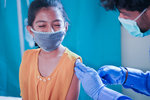



I am inspired to write this informational column on Long COVID following the NASEM (National Academies of Science, Engineering, and Medicine) issuing its new definition of this condition on June 11:
"Long COVID is an infection-associated chronic condition* (IACC) that occurs after SARS-CoV-2 infection and is present for at least 3 months as a continuous, relapsing and remitting, or progressive disease state that affects one or more organ systems."
Long COVID is not rare. Many of you readers likely know someone who suffers from Long COVID (LC). It affects 7% of Americans. That is 23 million people!
Long COVID does not discriminate. It can affect anyone: any age, any race, any gender, or any socioeconomic group.
Long COVID can follow an asymptomatic COVID-19 infection (one without symptoms). Not testing and not knowing you were infected will not necessarily protect you.
None of the above conditions are trivial. They are disabling and tricky to diagnose. Tricky because there are no definitive tests, they can be relapsing and remitting (i.e. they might come and go, wax and wane for no obvious reason), mimic many other conditions, and as such are challenging for clinicians to acknowledge. Many of those suffering have been told they are depressed or worried well, that it is in their heads.
Having one of these ‘vague’ conditions can be isolating and depressing.
A poignant example comes from a prior patient. She suffered from relapsing and remitting POTS and is an Emergency Department (ED) physician. POTS causes rapid heartbeat, weakness, and dizziness upon standing. When the POTS was active, she did not have the endurance to stand and reduce (i.e. put back in place) a dislocated shoulder which is a common traumatic condition ED physicians are required to treat. She would have to ask her colleagues to do this or any procedure that required strength while standing. It was significantly disabling sometimes enough that at times she could not work at all.
It took us a while to figure out what was ailing her. Us, because finding the diagnosis was a team effort, doctor and patient. With the diagnosis, we were able to come up with an action plan and treatments to help with the symptoms, even if not curative.
Long COVID can occur in a triad of symptom clusters: physical, psychological, and cognitive. They can range from mild to severe and may resemble symptoms of other illnesses.
Fatigue, brain fog, and post-exertional fatigue (tired after doing things, physically or mentally) are the most common but there are more than 200 long-term COVID symptoms.
Others include (this list is not comprehensive):
Physical - Fatigue, shortness of breath, muscle pain including chest, loss of smell, joint pain, headache, dry eyes and mouth, poor appetite, change in taste, dizziness from a variety of causes, diarrhea, diabetes, irregular and fast heart rates (arrhythmias), blood clots and sleep disturbances. It can worsen autoimmune diseases one already has or be the inciting event for one such as rheumatoid arthritis, lupus, psoriatic arthritis, and others.
Psychological: anxiety, depression, and PTSD
Cognitive: poor memory and concentration
Though there are no specific causal treatments for IACCs, it is still important to get diagnosed FIRST. Once diagnosed, there are many symptomatic and supportive treatments available to those suffering. Don’t resign yourself to ‘there is nothing to do.’
You may need and benefit from specialty evaluation with a cardiologist, pulmonologist, neurologist, or rehabilitation doctor. If you are short of breath, see what is causing this and receive care. If you have a new heart arrhythmia, get a diagnosis and treatment with a cardiologist. For long-term fatigue and disability, a rehabilitation doctor may be best suited to guide your care and treatment though interested primary care doctors can as well.
Powers that be, help us in Olympia to get appointments with these important specialists when we need them! Stay tuned for more columns on this and other related challenges as the doctor shortage crisis worsens.
Nonetheless, push for appointments and wait if you must. Don’t give up.
The cause is unknown. There is much active research happening to figure that out with many theories, none proven. We do know that some viruses pose a higher risk of post-infectious chronic conditions. For instance, COVID-19 poses a significantly greater risk than influenza.
Now that millions (sadly) are suffering from Long COVID, it is recognized and further defined, there has been a surge of research. It is research that will discover the cause(s) and treatment. Plus, that research will undoubtedly enlighten science in ways beyond what we can imagine. This surge of research and new definition is a gift to those suffering, particularly those who have been neglected or written off for so long with CFS, POTS, and chronic Lyme.
They are age>65 or being female >20 years, heavier weight, having had severe COVID-19 illness (being hospitalized), and not being vaccinated. Pre-existing health conditions such as depression, anxiety, allergies, and COPD also increase the risk.
It is known that in addition to reducing your risk of getting COVID-19, there are lower rates of Long-term COVID-19 in those who have been vaccinated, even if vaccinated AFTER being infected. Being infected does not fully protect you.
Eradicating a virus as sly as this one may be impossible. This bugger can powerfully mutate and evade our immune systems in its drive for survival. Some of those mutations (like with influenza) make the virus ‘immune’ to the vaccination. This is why new ones need to be manufactured as the virus mutates into new ‘variants.’ It is why, like with influenza, we need boosters.
A good friend and her elderly in-laws were recently infected by exposure to unvaccinated friends. Fortunately, they all suffered only mild short-lived symptoms. But having the infection puts one at risk for Long COVID.
Stay well and enjoy the upcoming summer!
2 comments on this item Please log in to comment by clicking here
Snevets
Thank you Dr. Glaser.
Wednesday, June 19 Report this
HotTractor
Thank you for this article. I've talked to three different people recently that have had COVID, and each of them say they are still suffering some debilitating effects. One had COVID in 2020 i think, one last year and another early this year. Two had Paxlovid.
I was with one person as they became sick, it was frightening how fast it progressed. Test kit showed positive. I'm sure would have ended up in hospital if not for Paxlovid.
Sunday, June 23 Report this